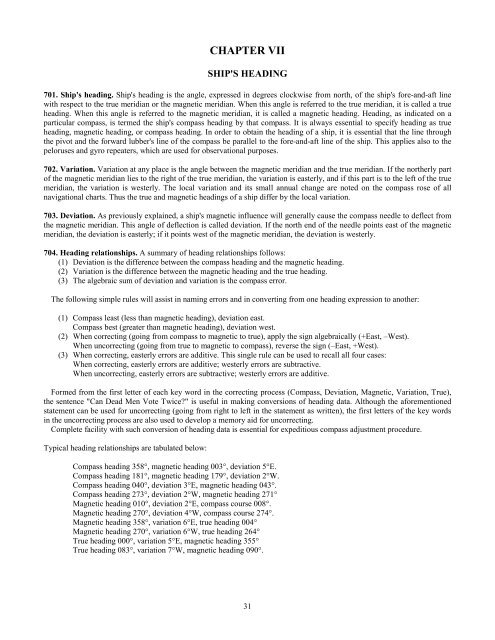Handbook of Magnetic Compass Adjustment - Maritime Safety ...
Handbook of Magnetic Compass Adjustment - Maritime Safety ...
Handbook of Magnetic Compass Adjustment - Maritime Safety ...
You also want an ePaper? Increase the reach of your titles
YUMPU automatically turns print PDFs into web optimized ePapers that Google loves.
CHAPTER VII<br />
SHIP'S HEADING<br />
701. Ship's heading. Ship's heading is the angle, expressed in degrees clockwise from north, <strong>of</strong> the ship's fore-and-aft line<br />
with respect to the true meridian or the magnetic meridian. When this angle is referred to the true meridian, it is called a true<br />
heading. When this angle is referred to the magnetic meridian, it is called a magnetic heading. Heading, as indicated on a<br />
particular compass, is termed the ship's compass heading by that compass. It is always essential to specify heading as true<br />
heading, magnetic heading, or compass heading. In order to obtain the heading <strong>of</strong> a ship, it is essential that the line through<br />
the pivot and the forward lubber's line <strong>of</strong> the compass be parallel to the fore-and-aft line <strong>of</strong> the ship. This applies also to the<br />
peloruses and gyro repeaters, which are used for observational purposes.<br />
702. Variation. Variation at any place is the angle between the magnetic meridian and the true meridian. If the northerly part<br />
<strong>of</strong> the magnetic meridian lies to the right <strong>of</strong> the true meridian, the variation is easterly, and if this part is to the left <strong>of</strong> the true<br />
meridian, the variation is westerly. The local variation and its small annual change are noted on the compass rose <strong>of</strong> all<br />
navigational charts. Thus the true and magnetic headings <strong>of</strong> a ship differ by the local variation.<br />
703. Deviation. As previously explained, a ship's magnetic influence will generally cause the compass needle to deflect from<br />
the magnetic meridian. This angle <strong>of</strong> deflection is called deviation. If the north end <strong>of</strong> the needle points east <strong>of</strong> the magnetic<br />
meridian, the deviation is easterly; if it points west <strong>of</strong> the magnetic meridian, the deviation is westerly.<br />
704. Heading relationships. A summary <strong>of</strong> heading relationships follows:<br />
(1) Deviation is the difference between the compass heading and the magnetic heading.<br />
(2) Variation is the difference between the magnetic heading and the true heading.<br />
(3) The algebraic sum <strong>of</strong> deviation and variation is the compass error.<br />
The following simple rules will assist in naming errors and in converting from one heading expression to another:<br />
(1) <strong>Compass</strong> least (less than magnetic heading), deviation east.<br />
<strong>Compass</strong> best (greater than magnetic heading), deviation west.<br />
(2) When correcting (going from compass to magnetic to true), apply the sign algebraically (+East, –West).<br />
When uncorrecting (going from true to magnetic to compass), reverse the sign (–East, +West).<br />
(3) When correcting, easterly errors are additive. This single rule can be used to recall all four cases:<br />
When correcting, easterly errors are additive; westerly errors are subtractive.<br />
When uncorrecting, easterly errors are subtractive; westerly errors are additive.<br />
Formed from the first letter <strong>of</strong> each key word in the correcting process (<strong>Compass</strong>, Deviation, <strong>Magnetic</strong>, Variation, True),<br />
the sentence "Can Dead Men Vote Twice" is useful in making conversions <strong>of</strong> heading data. Although the aforementioned<br />
statement can be used for uncorrecting (going from right to left in the statement as written), the first letters <strong>of</strong> the key words<br />
in the uncorrecting process are also used to develop a memory aid for uncorrecting.<br />
Complete facility with such conversion <strong>of</strong> heading data is essential for expeditious compass adjustment procedure.<br />
Typical heading relationships are tabulated below:<br />
<strong>Compass</strong> heading 358°, magnetic heading 003°, deviation 5°E.<br />
<strong>Compass</strong> heading 181°, magnetic heading 179°, deviation 2°W.<br />
<strong>Compass</strong> heading 040°, deviation 3°E, magnetic heading 043°.<br />
<strong>Compass</strong> heading 273°, deviation 2°W, magnetic heading 271°<br />
<strong>Magnetic</strong> heading 010°, deviation 2°E, compass course 008°.<br />
<strong>Magnetic</strong> heading 270°, deviation 4°W, compass course 274°.<br />
<strong>Magnetic</strong> heading 358°, variation 6°E, true heading 004°<br />
<strong>Magnetic</strong> heading 270°, variation 6°W, true heading 264°<br />
True heading 000°, variation 5°E, magnetic heading 355°<br />
True heading 083°, variation 7°W, magnetic heading 090°.<br />
31

















